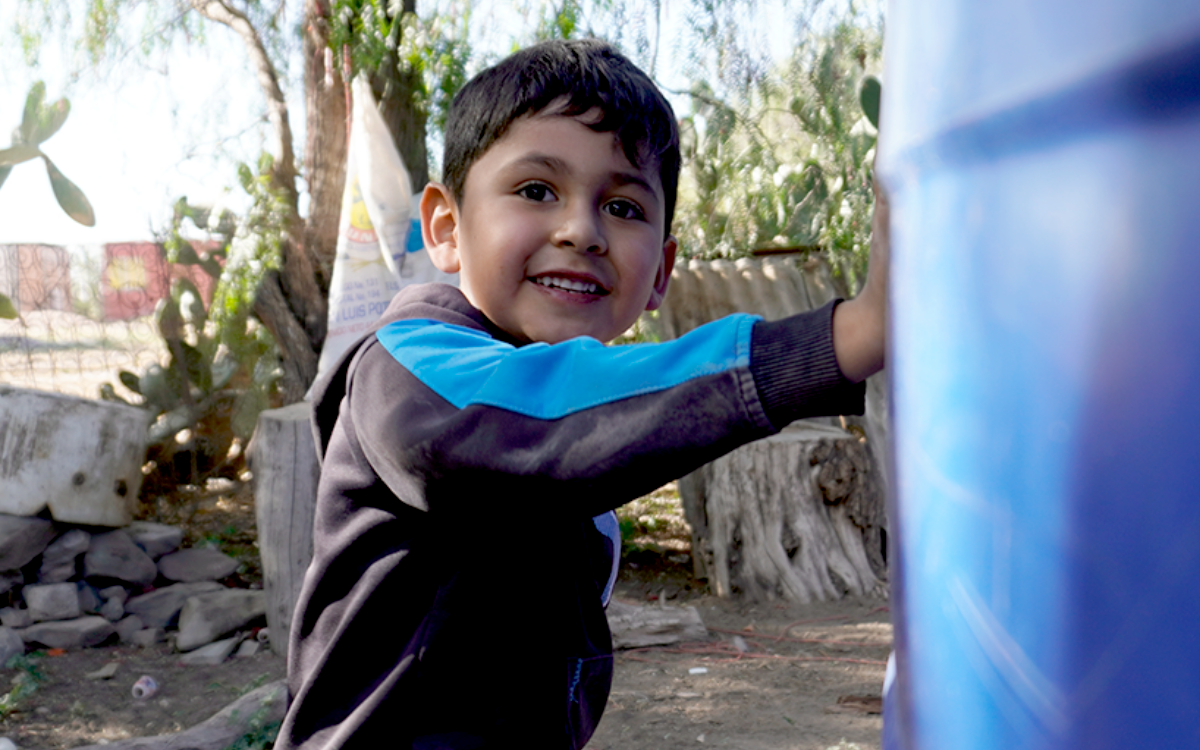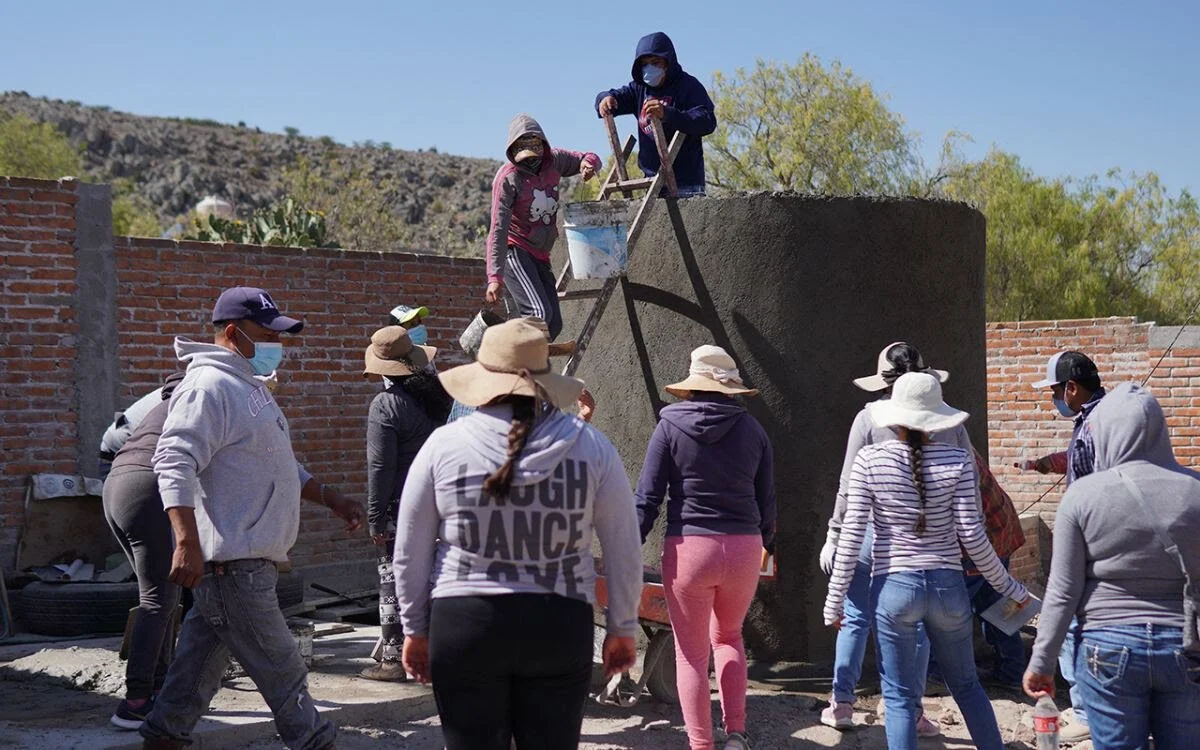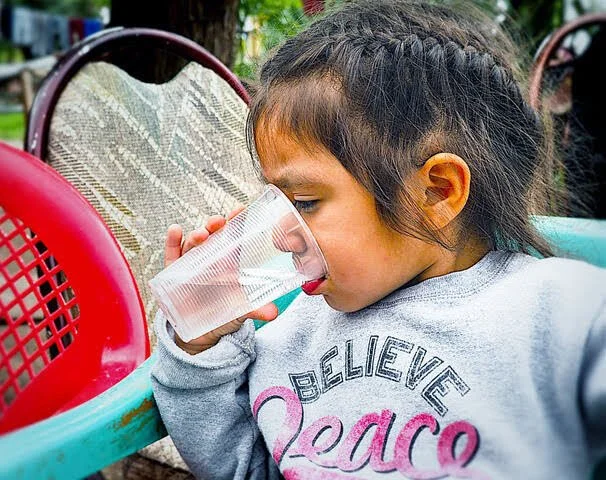Rainwater is Life, But Only if We Can Harness it
Photo: A young boy, from the Ejido de San Luis community, playing next to his family's rainwater harvesting system.
After a devastating year of drought in 2020, the rains have finally arrived in San Miguel de Allende and the surrounding region!
This brief annual period can provide enough clean drinking water for many of the 680,000 people who live in this region all year long, BUT only if we take advantage of this narrow window of opportunity to capture, store, and ultimately treat the rainwater to remove biological pathogens. Providing vital access to drinking water using rainwater harvesting has been one of Caminos de Agua’s most effective strategies over the last ten years. We have helped families, schools, and communities create millions of liters of rainwater storage, providing a lifetime of clean drinking water for thousands of people throughout northern Guanajuato State.
As proud as we are of these achievements, the plain truth is that it’s not enough. The Upper Río Laja aquifer is the main source of water for San Miguel and more than 2,800 other rural and urban communities. This finite resource is in a constant state of decline due to over-extraction primarily by the agricultural exporting industry, leaving entire communities without sufficient water to meet even their most basic needs. Capturing rainwater means relying less on depleting aquifers and provides a much more sustainable water source now and into the future.
With the changes caused by Climate Change we are getting roughly about the same amount of annual rain, but in a shorter period of time. So, we only have about 8 weeks to collect as much rainwater as possible before the dry season starts again. This year, at ‘Caminos’, we have a goal to build 150 large-scale rainwater harvesting systems in more than 20 communities – our most ambitious year by far to date! Help us achieve our goal by making a donation today. All donations made this month will go directly to building rainwater harvesting systems in communities that desperately need clean drinking water solutions today.
Photo: A group of community members working together in the construction of a Rainwater Harvesting System in the community of La Norita del Refugio, near San Luis de la Paz, Guanajuato.
Why Do We Drink the Rain?
Water supplies are becoming more scarce in our region every year and the remaining available water is becoming more contaminated with arsenic and fluoride, creating serious health threats for many in our region. When we describe this situation as being a “water crisis,” we are not being hyperbolic. Arsenic and fluoride are linked to a host of chronic health conditions such as dental and crippling skeletal fluorosis (browning of the teeth and deformation and weakening of the bones), chronic kidney disease, skin lesions, cognitive development and learning impairments in children, and several types of cancers. We have registered levels of fluoride and arsenic surpassing World Health Organization limits by 12 and 22 times respectively.
Removing arsenic and fluoride is no easy feat. These contaminants are completely dissolved in the water and traditional filters and treatment options – including expensive “whole house” filter systems commonly found throughout San Miguel – cannot touch them. Rainwater, however, is inherently free of these contaminants. When combined with our certified ceramic water filter to remove biological pathogens (i.e. “bacteria”), rainwater becomes one of the safest drinking water sources available.
While we are also developing other important new technologies that will provide clean drinking water faster, cheaper, and more effectively in the long-term, the fact remains that harvesting rainwater is the most actionable solution we can employ today to provide clean drinking water to the increasing number of people whose water supply and health is at risk, right now.
Photo: A little girl from the community of Pozo Hondo drinking filtered rainwater.
The Urgency Is Now
Our team is hard at work in 14 rural communities right now, partnering with them to build dozens of rainwater harvesting systems as well as providing educational programs and technical trainings. We are hustling to expand as quickly as possible to get more systems online while the rains are still falling. But to do that, we need your help!
We have continued to make our system building process more and more efficient and partner communities are providing most of the needed labor; however, expanding our capabilities to help more communities is expensive. Individual donations continue to be our single largest source of funding, and we feel enormous gratitude for all of your generosity. Join us in helping provide more families with life-sustaining drinking water through our rainwater harvesting programs by clicking the donate button.




